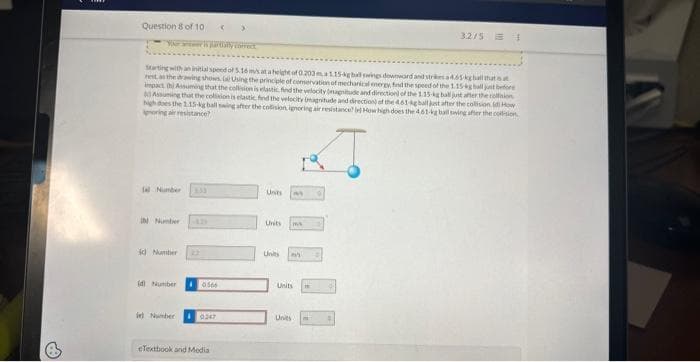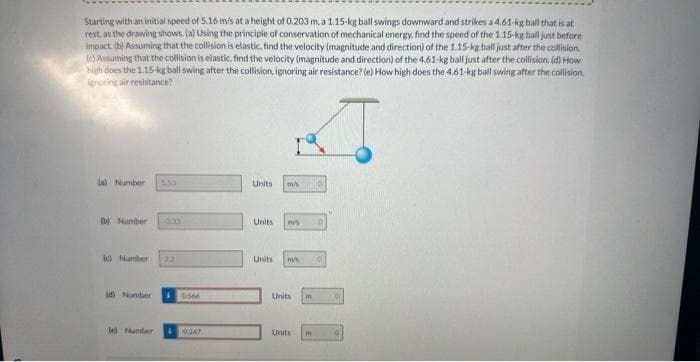Starting with an initial speed of 5.16 m/s at a height of 0.203 m, a 1.15-kg ball swings downward and strikes a 4.61-kg ball that is at rest, as the drawing shows. (a) Using the principle of conservation of mechanical energy, find the speed of the 1.15-kg ball just before impact. (b) Assuming that the collision is elastic, find the velocity (magnitude and direction) of the 1.15-kg ball just after the collision (c) Assuming that the collision is elastic, find the velocity (magnitude and direction) of the 4.61-kg ball just after the collision. (d) How high does the 1.15-kg ball swing after the collision, ignoring air resistance? (e) How high does the 4.61-kg ball swing after the collision. ignoring air resistance? J lal Number 5.33 (b) Number (Number (d) Number 0566 (el Number $ 0247 Units m/ Units M Units m/s G Units m Units m a
Starting with an initial speed of 5.16 m/s at a height of 0.203 m, a 1.15-kg ball swings downward and strikes a 4.61-kg ball that is at rest, as the drawing shows. (a) Using the principle of conservation of mechanical energy, find the speed of the 1.15-kg ball just before impact. (b) Assuming that the collision is elastic, find the velocity (magnitude and direction) of the 1.15-kg ball just after the collision (c) Assuming that the collision is elastic, find the velocity (magnitude and direction) of the 4.61-kg ball just after the collision. (d) How high does the 1.15-kg ball swing after the collision, ignoring air resistance? (e) How high does the 4.61-kg ball swing after the collision. ignoring air resistance? J lal Number 5.33 (b) Number (Number (d) Number 0566 (el Number $ 0247 Units m/ Units M Units m/s G Units m Units m a
College Physics
11th Edition
ISBN:9781305952300
Author:Raymond A. Serway, Chris Vuille
Publisher:Raymond A. Serway, Chris Vuille
Chapter6: Momentum, Impulse, And Collisions
Section: Chapter Questions
Problem 53P: A billiard ball moving at 5.00 m/s strikes a stationary ball of the same mass. Alter the collision,...
Related questions
Question
Please Asap

Transcribed Image Text:B
Question 8 of 10
Your
(al Number
IN Number
Starting with an initial speed of 5.16 m/s at a height of 0.203ma1.15-kg ball swings downward and striketa 4.65 kg
rest, as the drawing shows (al Using the principle of conservation of mechanical energy find the speed of the 1.15-4gball just before
impact the Assuming that the collision is elastic find the velocity nagnitude and direction of the 1.15-kg ball just after the collision
Assuming that the collision is elastic, find the velocity magnitude and direction) of the 461 kg ball just after the collision. How
high does the 1.15-kg ball swing after the collision ignoring air resistance? How high does the 461-kg ball swing after the collision
poring air resistance?
id Number 22
(d) Number
spartally correct
0.566
(
fel Number 10247
eTextbook and Media
Units
Units MA
Units an
Units
32/5
Units

Transcribed Image Text:Starting with an initial speed of 5.16 m/s at a height of 0.203 m, a 1.15-kg ball swings downward and strikes a 4.61-kg ball that is at
rest, as the drawing shows. (a) Using the principle of conservation of mechanical energy, find the speed of the 1.15-kg ball just before
impact. (b) Assuming that the collision is elastic, find the velocity (magnitude and direction) of the 1.15-kg ball just after the collision
(c) Assuming that the collision is elastic, find the velocity (magnitude and direction) of the 4.61-kg ball just after the collision. (d) How
high does the 1.15-kg ball swing after the collision, ignoring air resistance? (e) How high does the 4.61-kg ball swing after the collision
ignoring air resistance?
T
lal Number
(b) Number
(d) Number 32
(d) Number
0566
(el Number $ 0247
Units
m/
Units m
Units m/ O
Units m
Units m
a
Expert Solution
This question has been solved!
Explore an expertly crafted, step-by-step solution for a thorough understanding of key concepts.
Step by step
Solved in 4 steps

Knowledge Booster
Learn more about
Need a deep-dive on the concept behind this application? Look no further. Learn more about this topic, physics and related others by exploring similar questions and additional content below.Recommended textbooks for you

College Physics
Physics
ISBN:
9781305952300
Author:
Raymond A. Serway, Chris Vuille
Publisher:
Cengage Learning

Physics for Scientists and Engineers, Technology …
Physics
ISBN:
9781305116399
Author:
Raymond A. Serway, John W. Jewett
Publisher:
Cengage Learning

Principles of Physics: A Calculus-Based Text
Physics
ISBN:
9781133104261
Author:
Raymond A. Serway, John W. Jewett
Publisher:
Cengage Learning

College Physics
Physics
ISBN:
9781305952300
Author:
Raymond A. Serway, Chris Vuille
Publisher:
Cengage Learning

Physics for Scientists and Engineers, Technology …
Physics
ISBN:
9781305116399
Author:
Raymond A. Serway, John W. Jewett
Publisher:
Cengage Learning

Principles of Physics: A Calculus-Based Text
Physics
ISBN:
9781133104261
Author:
Raymond A. Serway, John W. Jewett
Publisher:
Cengage Learning

University Physics Volume 1
Physics
ISBN:
9781938168277
Author:
William Moebs, Samuel J. Ling, Jeff Sanny
Publisher:
OpenStax - Rice University

College Physics
Physics
ISBN:
9781938168000
Author:
Paul Peter Urone, Roger Hinrichs
Publisher:
OpenStax College

College Physics
Physics
ISBN:
9781285737027
Author:
Raymond A. Serway, Chris Vuille
Publisher:
Cengage Learning